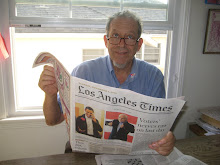PASTEL COLORS FOR THE HOI POLLOI
Pastel colors for the hoi polloi,
ultramarine and white reserved for saints,
the Virgin, and a most important goy
called Pontius Pilate. Colors of the paint
used by the brothers, Jean and Paul and Herman,
distinguish characters, the highlights in
the Book of Hours, illustrated sermon
designed to keep the readers far from sin,
but now delighting eyes of sinners who
can see the pictures in a darkened room
inside museums, where they are on view,
not warning people that they all face doom
if they do not believe the gory tale.
Different audience now, the Limbourg brothers
would have been proud their colors did not pale,
confined to books, unlike the art of others,
although their messages are mainly lost
to those who by their beauty are enticed
because they are less heartwarming than frost
to those locked in their skeptical Zeitgeist.
Inspired by a review in the WSJ on January 21, 2009 by David Littlejohn of an exhibition of the Limbourg brothers’ “The Belles Heures of the Duke of Berry” at the Getty Museum that Linda and I went to see January 25, 2009. It was one of the most moving exhibitions either of us had ever seen. The imagery is artistically exquisite and narratively fascinating, but, as I imply in the final quatrain, it is difficult to engage cognitively with works whose religious rationale is so foreign to our own. Littlejohn writes:
When the billion-dollar Getty Center opened on its hilltop here 11 years ago, I found myself resisting the museum's skylit galleries upstairs, full of paintings by old and new masters. Instead, I was drawn to two small, dark galleries downstairs on the east side of the central court. These galleries were kept dark because their contents -- drawings and watercolors in one, illuminated manuscripts in the other -- would be wounded by an excess of light. Pinpoint spotlights lit up each small work on display, inviting the viewer to an intimate communion with both art and artist.
Since 1983, the Getty has owned a treasure trove of illuminated European manuscripts made between the 10th and the 16th century. Some of these are shown in rotation every few months, along with prize loans from other collections. On first viewing a sample of the Getty's medieval manuscripts in 1997, I wrote, "Letting your eye course around the intricate lines and details, feasting on the gold and the brighter-than-life colors, trying to get inside the rapturous imaginations of these meticulous miniaturists felt like going to heaven." Now the Getty's manuscript rooms house what may be the most important exhibition of handwritten, hand-painted medieval manuscript pages ever displayed.
On the walls of these two rooms hang framed pairs of small illustrated pages created in France between 1405 and 1409. In free-standing, double-sided glass cases in the middle of the rooms seven more bifolios are shown, allowing viewers to see 26 more paintings on both the front and back of vellum sheets. Altogether, one can see at the Getty 84 of the 172 paintings made by Herman, Paul and Jean de Limbourg -- three brothers born in what is now the Netherlands -- for an illustrated devotional book, or Book of Hours, called "Les Belles Heures du Duc de Berry." Most of the paintings are about 3¼ by 4 inches in size, captioned by four lines of Latin text with oversize, illuminated capitals and surrounded by wide borders of tiny bryony leaves on coiling vines. Four are the size of a large postage stamp, and nine -- inserted into columns of text -- about the size of a business card. But even these can be filled with minute, intricate detail. Thoughtfully, the museum leaves magnifying glasses about in wall racks.
The "Belles Heures" is the second most beautiful book I know of, surpassed only by the "Très Riches Heures," half-completed by the same three brothers for the same royal duke -- before all four died, presumably from the plague, in 1416.
The "Belles Heures" was bought in 1954 from the Paris branch of the Rothschild banking family by the Metropolitan Museum of Art in New York. In 1996 the Met had the pages removed from their bindings to allow a Swiss publisher to make a posh limited-edition facsimile, copies of which currently go for $13,000 to $14,000. Good color reproductions of all the paintings also appear in the $65 book that accompanies this exhibition, ably composed by curator Timothy Husband.
When the folios were separated in 1996, conservators at the Met discovered that many of the paintings were succumbing to the passage of time. Over several years, many square millimeters of flaking paint were painstakingly fixed back in place.
In addition to the sheer beauty, finesse and detail of so many of their miniature paintings, a part of the miracle of the "Belles Heures" is the artists themselves. Herman, Paul and Jean de Limbourg were first hired when they were 17, 16 and 14 years old, to illustrate a Bible for the Duke of Burgundy, the Duke of Berry's brother. When Burgundy died two years later, his wealthy, art-mad brother took on these teenage prodigies to create the "Belles Heures" -- and, after that, all or part of 72 paintings for his incomparable "Très Riches Heures."
The most memorable pages in the first room here are those bearing painted scenes from the life of the Virgin Mary and a nearly complete series of 14 images of the passion and death of Christ. Many of these intimate human/divine dramas are framed in detailed architectural fragments, set in buildings out of scale with their occupants or backed by gilt-patterned wallpaper, castellated cities and steep, twisting, conical mountains.
The characters in each scene convey inner emotion both by the postures and curves of their bodies (the naked Christ, both suffering and dead, is long, lean and real) and the individualized expressions on their faces. Most of these characters wear beautifully draped and molded pastel-colored robes -- lavender, lemon, pale green, pale blue and rose. Bright white and dazzling ultramarine (made from ground lapis lazuli) are saved for special people, like the Virgin, the high priest and Pontius Pilate. Gold leaf or gold powder in emulsion (sparkling under the spotlights) is saved for halos, the crowns and gifts of the three kings, bits of armor and rays coming down from heaven. Special prizes include the tender, close-up "Flight Into Egypt"; "The Flagellation," with the stripped Christ impassive before his flailing tormentors; the even more poignant "Christ Nailed to the Cross," with its wild angles, complex cast, and flashes of red-orange; the dark, near monotone "Death of Christ"; and the sublime "Lamentation." The broad leap toward physical and emotional realism presented in these paintings gives the Limbourgs -- who come between Giotto and Van Eyck -- an essential role in the 15th-century shift from medieval symbolism and simplicity to the full-scale humanism of the Italian Renaissance. One great painting -- "Heavenly Hosts," illustrating the feast of All Saints -- retains the patterned symmetry and hierarchy of the earlier tradition, while giving individual features to a multitude of saints honoring Mary and her son in a sumptuously bordered heaven.
In the room across the hall are displayed paintings that seem to me of slightly less artistic ingenuity and importance, and of less compelling emotional impact on the average modern viewer. These include 14 images of individual saints as well as portions of extensive cycles devoted to St. Catherine, St. Jerome and other early Christian worthies. The room does contain impressive storms at sea, bloody tortures and beheadings, plague victims in convulsions and moving images of favorite Christian saints, in the Limbourgs' usual blend of well-chosen colors sprinkled with gold.
When their display here ends Feb. 8, these 600-year-old sheets of inscribed and painted cowhide will be put back to sleep for seven months. They will then be exposed in a once-in-a-millennium show of all 172 images -- in two-sided cases -- at the Lehman Wing of the Metropolitan Museum of Art, which is scheduled to open Sept. 2. A selection of unbound pages will be sent to the Louvre in Paris in 2011.
Once rebound, this unique book will return to the locked archives of The Cloisters (the Medieval wing of the Metropolitan), to be viewed -- apart from a short annual showing of the volume opened to one pair of pages -- only by bona-fide scholars wearing white gloves. See it while you have the chance.
© 2009 Gershon Hepner 1/25/09
Saturday, January 24, 2009
Subscribe to:
Post Comments (Atom)


No comments:
Post a Comment